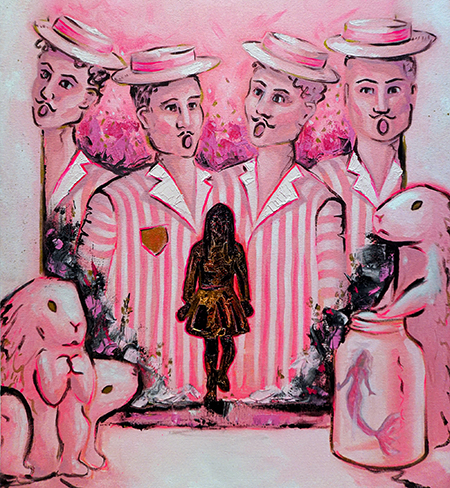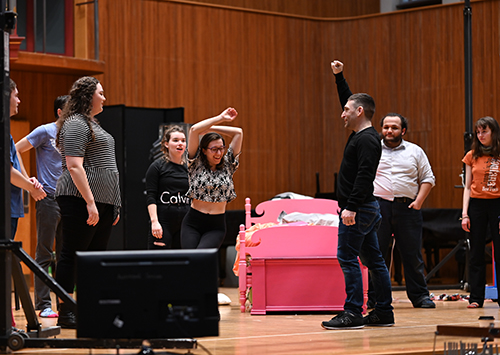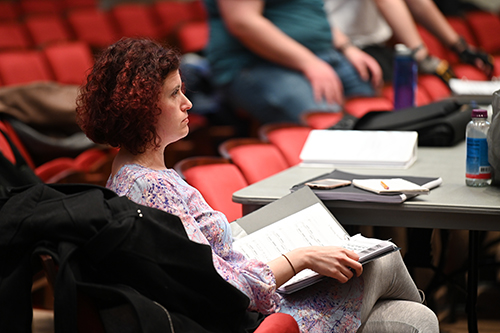by Mike Telin

A new addition to opera with a child/parent theme is Rachel J. Peters’ The Wild Beast of the Bungalow with libretto by Royce Vavrek. The work, presented by Oberlin’s Winter Term Opera and directed by Christopher Mirto, will receive its world premiere on Wednesday, January 29 in Warner Concert Hall. Additional performances run from Friday, January 31 through Sunday, February 2. All begin at 7:30 pm and will be followed by a talkback with members of the artistic staff, performers, and the creative team. The event is free, but reservations are required. The Wild Beast of the Bungalow is the inaugural work of the Oberlin Opera Commissioning Project.
With a duration of 90 minutes and a cast of one coloratura soprano with eight additional principals playing multiple roles, the opera is played out in three sections. The plot unfolds in the bedroom of a nameless eleven-year-old Girl, where, over the course of a few days, a mermaid, a family of stuffed prairie dogs, and singing groups of chickenpox and shingles force her to come to terms with what it means to care for others and to allow others to care for you.
The opera opens with the parents fighting. “The theme that travels through the piece is ‘I never asked to care for something,’” Christopher Mirto said during a recent telephone conversation. “The Girl overhears this said about her, and the way that she engages with that is to dive straight into her imagination.”

In the third part, ‘Fine and Dandy,’ the Girl comes down with the chickenpox and her mother contracts shingles. “They’re both ailing from stress and she imagines that the diseases come to life. Sprinkled in between each of these sections are little blasts of the parents arguing. So, for me, it’s a piece about the power and thrill of the imagination and this moment when you suddenly realize that your parents are people.”
If this all sounds a little bizarre and far-fetched, Mirto said that is exactly what drew him to the piece. “When I read it the first time I was completely smitten with the prairie dogs. I have a very high threshold for weird but I couldn’t believe what I was reading, and I was totally sold.”
Mirto first became aware of The Wild Beast of the Bungalow right after he came to Oberlin. “I’ve known Royce [Vavrek] for a long time, so when I got this job I called him up and said ‘I get to start directing opera. Send me what you have,’ and this was one of the scores he sent me.” He added that when the Oberlin Opera Commissioning Project was launched last year he was faced with a timeline that didn’t permit the first endeavor to be created from the ground up.
“I loved this weird, quirky opera, and I thought, it’s almost done, it’s never had a premiere, so this is a perfect launch for the commissioning project. It’s kind of a completion commission — the orchestrations are new, Rachel and Royce did some work on the libretto, and this is the first official cast, design team, and orchestra to bring it to life.”
The completion process began in September 2019, when Rachel Peters paid a visit to Oberlin. During that period a workshop cast recording was made, which allowed everyone to hear the piece for the first time. “Rachel went away and made the orchestrations, which we received just before Thanksgiving. We’ve been in rehearsals since January 3. We spent the first week learning the music with Dan Michalak, the vocal coach, and then dove directly into staging. We go into tech this Saturday, so it’s been a quick and dirty process.”
The director said he is setting the opera in what “feels like the 1980s with a lot of throwbacks to the musical styling of the 40s 50s and 60s.” He added that it’s a pre-technology world without cell phones and computers.
During his time at Oberlin Mirto has not shied away from staging Winter Term operas that present the students with many musical and production challenges, and The Wild Beast of the Bungalow is no exception. In 2018 he staged Du Yun’s Angel’s Bone, and in 2019 Missy Mazzoli’s Proving Up. Coincidently, all three operas feature librettos by Royce Vavrek.

Mirto said he finds the Winter Term Opera to be both artistically and academically satisfying. “It’s fun to interact with students in a way that resembles more of a professional dynamic. They’re not in classes, so they are able to focus more intensely on the rehearsal process, design process and a saturated musical process. Everyone is doing significant work, that if it didn’t get done we’d all be behind.”
The production team also includes a team of dramaturges led by Musicology Professor James O’Leary who are charged with the tasks of putting together supertitles, producing the program and organizing the post-performance talkbacks. They are also responsible for assembling research packets, which Mirto said included writings on the psychology of children and their relationship to toys, and a music video guide of all the different musical styles that Rachel Peters uses in the show — The Shirelles, Tiny Tim, Oliva Newton-John. “Obviously, there was tons of prairie dog stuff,” Mirto said. “It also explained what it meant to have chickenpox before vaccination, and how you contract shingles. It was good stuff.”
Unlike his two previous productions, both of which had already received performances and provided reference points, Mirto said that The Wild Beast of the Bungalow presents him and his creative team with many question marks. “We’re figuring things out and that’s beautifully frustrating, fulfilling, and exciting.”
Poster art by Steven Mentzer. Photos by Yevhen Gulenko.
Published on ClevelandClassical.com January 25, 2020.
Click here for a printable copy of this article




